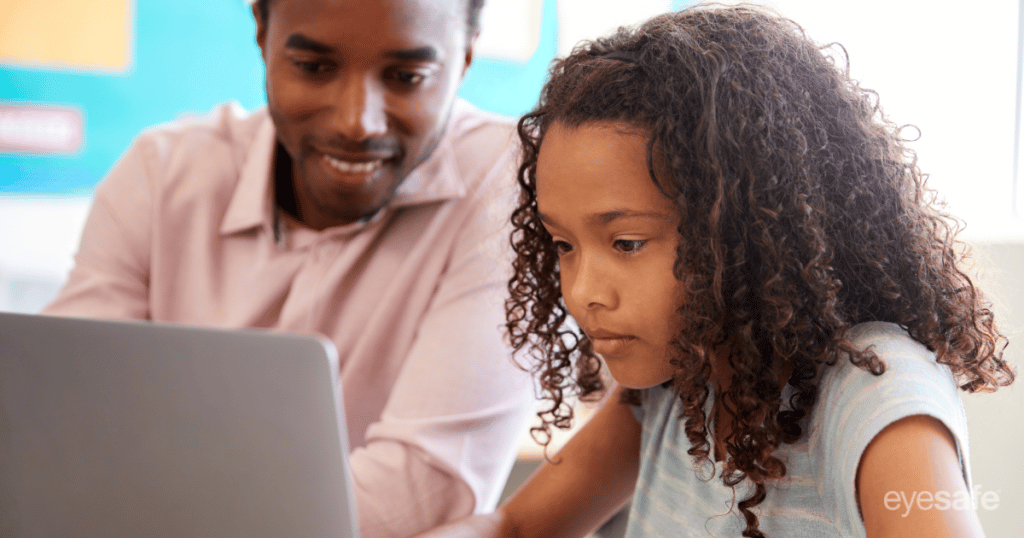Blue light exposure has been shown to have negative effects on sleep, which can in turn impact a person’s emotional well-being. Research has shown that exposure to blue light at night can disrupt the body’s natural circadian rhythm, making it harder to fall asleep and leading to feelings of fatigue and irritability during the day. This can affect mood, cognitive function and may have negative impact on Social-Emotional learning (SEL) of children.
SEL is the process through which children and adults understand and manage emotions, set and achieve positive goals, feel and show empathy for others, establish and maintain positive relationships, and make responsible decisions. Poor sleep caused by blue light exposure can affect SEL by making it harder for children to regulate their emotions, form and maintain positive relationships, and make good decisions.
Additionally, as many students in recent years have been increasingly exposed to screens and blue light for a long period of time in order to keep up with virtual and remote learning, it has been an even bigger concern for educators to address and for parents to be aware of.
Therefore, it is important for educational institutions and parents to be aware of the potential effects of blue light exposure on students’ emotional well-being and to take steps to protect students from excessive blue light exposure.
There are several ways educators can protect students from excessive blue light exposure:
 1. Install blue light screen protectors on student devices, such as Chromebooks and tablets.
1. Install blue light screen protectors on student devices, such as Chromebooks and tablets.
This is an easy and cost-effective way to reduce blue light exposure. The screen protector provides “always-on” filtration of blue light. It’s important to find a reputable blue light company to ensure the products are effective. Eyesafe® Screen Protectors have been developed with ophthalmologists and optometrists to filter more than 40% of blue light*, and are independently tested and certified for efficacy.
2. Encourage regular breaks from screens.
Educators can encourage students to take regular breaks from screens, such as every 20-30 minutes, to give their eyes a rest. During these breaks, students can stretch, move around, or engage in other activities that do not involve screens.
3. Use natural light.
Whenever possible, use natural light instead of artificial light in classrooms. This can help to reduce the amount of blue light exposure students receive during the day.
4. Encourage healthy sleep habits.
Educators can encourage students to establish healthy sleep habits, such as going to bed and waking up at the same time every day, by creating daily schedules to follow.
5. Promote digital wellness.
Educators can promote digital wellness by incorporating lessons on the effects of blue light, the importance of taking breaks from screens, and healthy sleep habits into the curriculum.
6. Incorporate physical activity.
Encourage students to engage in physical activity during the day to reduce the amount of time they spend in front of screens.
It’s also important for educators to lead by example, by reducing their own screen time and promoting healthy habits related to blue light exposure to their students. By taking these steps, educators can help to protect students from excessive blue light exposure and promote healthy emotional well-being.
For more information on reducing blue light in the classroom, contact Eyesafe at [email protected].
*40% of blue light filtered at 435-440 nanometers
About Eyesafe
Eyesafe Inc. is the world leader in blue light management, including display technology, standards, certification, and accessory solutions. With an expansive portfolio of intellectual property, the company employs a world-class team of eye doctors, engineers, and scientists with decades of experience in electronics, display materials, light management, optometry, and ophthalmology. The Eyesafe brand is trusted by consumers and integrated in millions of digital devices from Dell, HP, Lenovo, LG, ZAGG and more. Eyesafe is recognized by Inc. 5000 as one of the fastest growing private companies in America and by the Minneapolis/St. Paul Business Journal as the #1 Fastest Growing Company in Minnesota. Learn more at eyesafe.com.
Media Contact:
Arick Wierson
+1 952-999-1741
[email protected]

